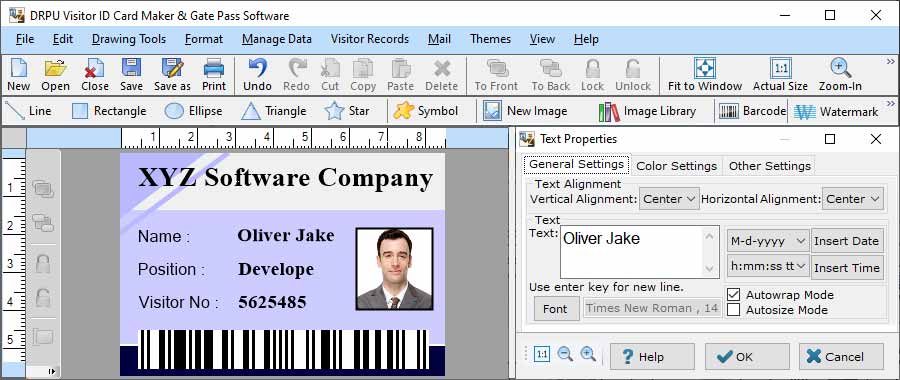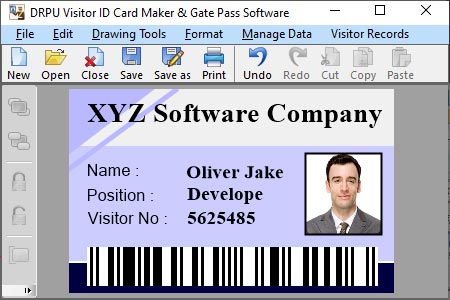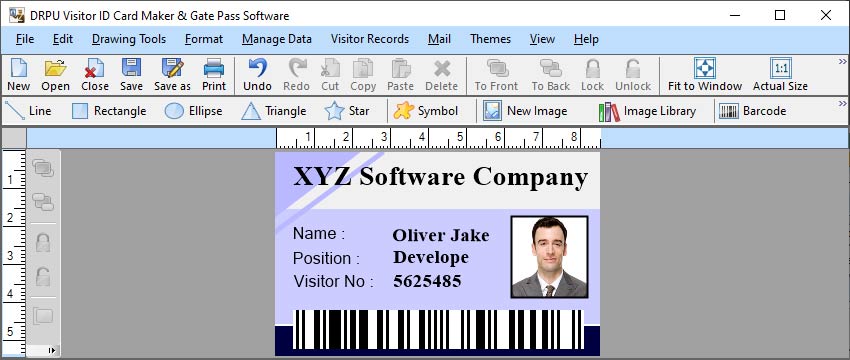A gate pass maker is a software application or tool designed to create gate passes or entry permits for individuals entering a restricted area or premises. It provides a digital solution to manage and track the movement of people within an organization or a controlled environment. Gate passes are typically used in places such as corporate offices, government institutions, educational campuses, industrial facilities, and events where controlled access is required.

The primary purpose of a gate pass maker is to streamline the process of issuing and managing gate passes, replacing traditional manual methods like paper-based passes or logbooks. It allows administrators or authorized personnel to generate gate passes electronically, store relevant information, and track the entry and exit of individuals in real-time.
By: Techsavvy
Published: 03/08/2023
Key Features and Functionality of a Gate Pass Maker:
🞛 Gate Pass Generation: The software enables users to create gate passes by entering relevant information about the visitor or the person requiring access. This information may include their name, contact details, purpose of visit, date and time of entry, and duration of access.
🞛 Customization: Gate pass makers often offer customization options to tailor the gate passes to specific requirements. Users can add logos, branding elements, or other visual identifiers to the passes.
🞛 Security Enhancements: Gate pass makers incorporate security features to prevent counterfeiting and unauthorized access. These may include barcode or QR code generation for each gate pass, making it scannable at checkpoints. Additionally, some systems may include photo capture and ID verification to ensure the identity of the pass holder.
🞛 Real-time Tracking: The software allows for real-time monitoring of the movement of individuals with gate passes. It provides visibility into who is inside the premises, their entry and exit times, and their purpose of visit. This information can be useful for security purposes, attendance tracking, or compliance reporting.
🞛 Notifications and Alerts: Gate pass makers may include notification capabilities to alert administrators or concerned parties when a gate pass is issued, expired, or when certain predefined events occur. This helps in maintaining situational awareness and managing access effectively.
🞛 Reporting and Analytics: Gate pass makers often offer reporting features to generate various types of reports, such as visitor logs, access history, or statistics on the frequency of visits. These reports can aid in identifying patterns, improving security protocols, or complying with regulatory requirements.
Benefits of Using a Gate Pass Maker:
Gate pass makers streamline the process of issuing passes, eliminating manual paperwork and reducing administrative tasks. This saves time and effort for both the staff and the visitors.
The use of digital gate passes with built-in security features reduces the risk of unauthorized access, counterfeiting, or tampering. It allows for better control and monitoring of individuals entering the premises.
Gate pass makers can provide a smoother and more professional experience for visitors. The automated process minimizes waiting times, improves accuracy in data capture, and provides a more seamless entry experience.
Gate pass makers centralize and manage visitor data, making it easier to track, analyze, and comply with data protection regulations. It simplifies record-keeping and ensures the privacy and security of visitor information.
The tracking and reporting capabilities of gate pass makers facilitate auditing and provide an audit trail for access events. This helps identify any irregularities, resolve disputes, or investigate security incidents.
When troubleshooting issues with a Gate Pass Maker, it's important to follow a systematic approach to identify and resolve the problem. Here are some steps you can take to troubleshoot common issues:

-
1Identify the Problem:
Start by clearly understanding the issue you are facing. Is the problem related to software functionality, hardware components, connectivity, or user error? Gather information about the symptoms, error messages, or any specific circumstances that led to the problem.
-
2Check Power and
Connections:
If the Gate Pass Maker involves hardware components, ensure that all power connections are secure and the devices are properly plugged in. Check cables, connectors, and power sources to rule out any loose connections or power supply issues.
-
3 Restart the System:
Often, a simple system restart can resolve minor software or temporary glitch-related issues. Restart the Gate Pass Maker software or the entire system if necessary, and check if the problem persists.
-
4 Review Error
Messages and Logs:
If there are error messages or system logs available, carefully review them to gather more information about the issue. Error messages can provide valuable clues about the root cause of the problem.
-
5 Consult
Documentation:
Refer to the user manual or documentation provided by the Gate Pass Maker manufacturer for troubleshooting guidance. Look for specific sections related to common issues, error codes, or troubleshooting steps. The documentation may also contain a FAQ section that addresses common problems and their solutions.
-
6 Internet Connectivity:
If the Gate Pass Maker relies on internet connectivity for certain features or updates, ensure that the internet connection is stable and working properly. Check network cables, Wi-Fi settings, or network configurations to rule out any network-related issues.
-
7
Update Software and Firmware:
Check if there are any available software updates or firmware updates for the Gate Pass Maker. Outdated software or firmware versions can sometimes lead to compatibility issues or bugs. Follow the manufacturer's instructions to install the updates and see if it resolves the problem.
-
8
Check Hardware Components:
If the Gate Pass Maker involves physical hardware components like printers, scanners, or card readers, verify that they are functioning correctly. Check for any paper jams, low ink levels, or mechanical issues. Refer to the manufacturer's guidelines for troubleshooting specific hardware components.
-
9
Disable Conflicting Software:
In some cases, conflicts with other software installed on the system can cause issues. Temporarily disable or uninstall any recently installed software that may be interfering with the Gate Pass Maker's functionality.
-
10 Contact Support:
If you are unable to resolve the issue using the steps above, reach out to the manufacturer's support team or the vendor from whom you purchased the Gate Pass Maker. Provide them with a detailed description of the problem, steps you have taken so far, and any relevant error messages or logs. They should be able to provide further assistance or escalate the issue if needed.
Considering these steps, Remember to document the troubleshooting steps you have taken, including any changes or actions performed, as this information can be helpful for support teams or technicians when providing assistance.
Ensuring that your gate pass maker is secure and reliable is crucial to protect your organization's assets, maintain the safety of your premises, and prevent unauthorized access. Here are some key steps and considerations to help you achieve this:

Implement a robust authentication system: Require strong passwords, multi-factor authentication (MFA), or biometric authentication for access to the gate pass maker software.
Control access privileges: Assign different levels of access based on user roles and responsibilities. Only authorized personnel should have access to sensitive features or data.
Audit logs: Maintain detailed logs of user activities, including login attempts, gate pass creation, modifications, and deletions. Regularly review these logs for any suspicious activities.
Choose a reputable vendor: Select a gate pass maker software from a trusted and well-established vendor with a proven track record in security.
Regular software updates: Ensure the software is regularly updated with security patches and bug fixes. Stay up to date with the latest version to benefit from the latest security enhancements.
Secure coding practices: The software should be developed following secure coding practices, such as input validation, secure session management, and protection against common vulnerabilities (e.g., SQL injection, cross-site scripting).
Regular security assessments: Conduct regular security assessments, such as penetration testing, to identify and address any vulnerabilities in the software.
Encryption: Implement strong encryption mechanisms for sensitive data, both during transmission and storage. This includes the gate pass data, user credentials, and any personally identifiable information (PII).
Data backups: Regularly back up the gate pass data and store it securely in case of data loss or system failure.
Data retention and disposal: Define clear policies for data retention and disposal. Ensure that expired or outdated gate pass records are securely deleted or archived.
Server and infrastructure security: Ensure that the servers and infrastructure hosting the gate pass maker software are physically secure, protected against theft, and have appropriate access controls.
Restrict physical access: Limit physical access to the gate pass maker system to authorized personnel only. Use secure cabinets or server rooms with restricted access controls.
Training and awareness programs: Provide regular training and awareness sessions to users on security best practices, such as creating strong passwords, recognizing social engineering attacks, and reporting suspicious activities.
Security policies and procedures: Develop and communicate clear security policies and procedures to all users. This should include guidelines on password management, acceptable use of the gate pass maker software, and incident reporting procedures.
Conduct periodic audits: Regularly assess the security controls, processes, and configurations of your gate pass maker system to ensure they align with industry best practices and compliance requirements.
Compliance with regulations: Understand and comply with relevant security and privacy regulations specific to your industry or region (e.g., General Data Protection Regulation - GDPR, Payment Card Industry Data Security Standard - PCI DSS).